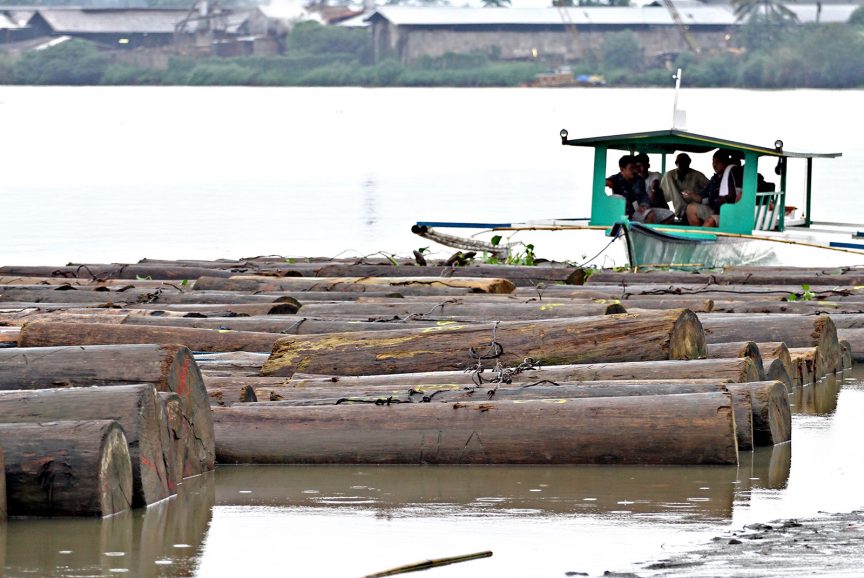 Members of the Public Safety Company of Butuan City police discover these large lauan logs floating by the bank of the Agusan River in Barangay Mahogany in Butuan, on Nov. 29, 2013. Deforestation has been blamed as a major cause of climate change. MindaNews file photo by ERWIN MASCARINAS
Members of the Public Safety Company of Butuan City police discover these large lauan logs floating by the bank of the Agusan River in Barangay Mahogany in Butuan, on Nov. 29, 2013. Deforestation has been blamed as a major cause of climate change. MindaNews file photo by ERWIN MASCARINAS
DAVAO CITY (MindaNews/18 August) – Unpredictable weather patterns attributed to climate change threaten shrimp production, a co-owner of the largest homegrown shrimp grower in Davao Region said Friday.
Anders Haagen, a co-owner of Anderlude Seafoods Corp., said changes in weather patterns weather concern them as these would affect the growing and production of shrimps in their three locations in the region – Dumoy in Davao City, and Sta. Cruz and Hagonoy in Davao del Sur.
“There is climate change. If we are only a farmer, then you can’t control the climate and we have experienced a lot more rain lately, we experienced a lot of things. It makes it more risky and more dangerous to be the farmer alone,” he told reporters during the opening of their processing plant at the state-owned Davao Fish Port Complex in the fishing barangay of Daliao, Toril in Davao City.
He said they had invested in this new undertaking, the only one of its kind in the region, to “spread out our risk a little bit” by participating in processing that would add value to the products.
“But when you process, your risk profile is much lower.
If it rains for two months, we don’t care. We don’t lose the whole harvest, so it’s a much more predictable business, and more predictable means more manageable,” he said.
Haagen said their company produced about 1,000 tons of shrimps that were sold directly to markets around the region and Manila and they are expecting to produce 800 to 1,000 tons of shrimp within the year.
His partner, Ludevito S. Batilong, president of Anderlude, said no plans for export are being considered at present because they want to satisfy the domestic demand first.
He said Davao City’s demand alone ranges from 5 to 10 tons a day and their company is shipping about 10 containers, or 140 to 180 tons every month to Manila.
He said they have 127 hectares of shrimp farms — 45 hectares in Dumoy, 14 hectares in Sta. Cruz and 68 hectares in Hagonoy.
The two started with only two hectares of shrimp nursery.
Haagen said the outbreak of avian flu in San Luis, Pampanga will increase the demand for seafood.
The Danish businessman said he and Batilong engage in sustainable shrimp production, meaning they use neither chemicals nor antibiotics to control the bacteria in the shrimp pens.
“I like it because it’s very sustainable. They way we do this is to use effective microorganisms. What we do is we drop them in the pond, and they eat the sludge, so the good bacteria when they eat the sludge, they clean the pond. But because [the] nature of bacteria [is] if they populate the sludge, then no other bacteria can move in,” he said.
He said “when these good bacteria have populated, there is no risk of invasion by bad bacteria” and it becomes good bio-protection from pests and diseases.
“These bacteria when they multiply, they float up and get eaten by the shrimp,” he said.
He said any good bacteria can be used because it’s not pathogenic and will not harm humans.
Haagen also bared plans to expand to Rizal town in Palawan, a move that will increase by two-fold their shrimp production.
He said a sister company there operates a coconut plantation, and the throwaway coconut husks can be a great source of electricity to operate the “paddle wheels that aerate the shrimp ponds.”
“So in order to have a sustainable coconut business, we can take all the wastes from our coconut business, use it to generate electricity and the electricity runs a shrimp farm. No waste, no pollution,” he said. (Antonio L. Colina IV/MindaNews)
